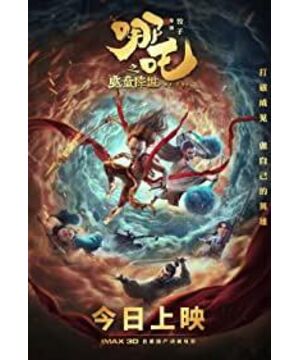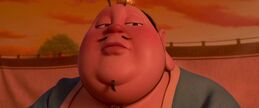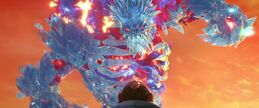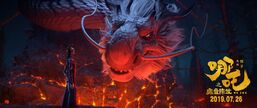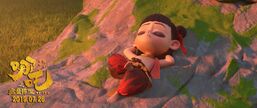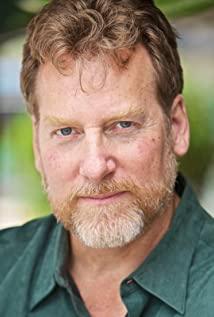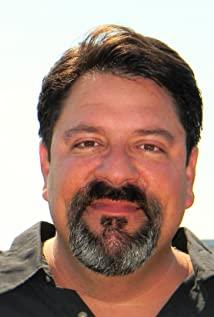I have watched this movie two days before the screening, but I haven’t written a review because of a conflicted mood. I want to wait for its word of mouth to naturally ferment before I can talk about my views and prepare a story.
To put it simply, I am very impressed with the technical elements of the film's art, soundtrack, storyboards, and imagination, but I am very disappointed with the plot. The first impression after watching it is that this film has completed the four kings of the "post-"The Return of the Great Sage" era": "Big Fish and Begonia", "White Snake", "Wind Spell", "Nezha Devil Child Comes into the World" .
The common features of the Four Kings in the post-"The Return of the Great Sage" era are that the technical level is close to the world's leading edge, and the art style of music and pictures has a strong Chinese style, which is amazing; but the theme is weak and kitsch, and the plot is even more messed up. The film is both admirable and disappointing, and it's all too much to criticize, but a little too hard to criticize.
When the feeling of "can't bear to criticize" appeared for the fourth time, it was time to discuss why.
I think, as a middle-aged person, I still have so much expectation and tolerance for domestic animation films, only to explain one reason: my own childhood was deeply influenced by domestic animation, and this influence was so positive that Decades later, with a rich knowledge structure and tortuous social experience, not only did he not laugh at the low aesthetics of his childhood, but he was full of respect for the spiritual energy endowed by these works.
The post-80s generation can always name a lot of classic domestic animation films. The standouts are the three films "Monkey King", "Nezha", "Tianshu Qitan"; as well as many supernatural art animation short films "Little Tadpoles Looking for Mother", "Shepherd Boy", "Nine-colored Deer", etc. . Their artistic value is universally recognized, even inspiring and motivating animation masters like Hayao Miyazaki. Many other masterpieces also have an unbreakable place in our memory, such as "Hulu Baby", "Black Cat Sheriff", "Ginseng Baby", "Magic Pen Ma Liang", "Fisherman", "Mindless and Unhappy", "The Sloppy King"... To this day, I also think that letting my children watch these decades-old animations is a hundred times better than those drooling children's animations that sell cute toys.
I will proudly admit that these animations played an important role in shaping my personality. And what is proud of is that the Chinese aesthetics and spirit of Chinese culture contained in these works are irreplaceable and unique in Japanese and Western works.
Therefore, when people reach middle age, they still have such expectations for children's animation, which all stem from the continuation and projection of the emotion of the term "domestic animation". Furthermore, we hope that the cultural food and spiritual energy that we obtained as children can be continued in the generation of our children.
The last brilliance of domestic animated films may be "Lotus Lantern", but it can also be regarded as the sunset before the night. Although it tried to imitate the narrative style of Hollywood animation, it was a complete defeat in terms of technical indicators compared to "The Lion King" four years ago. So the ending can only make people sigh.
I think that since then, many Chinese people who are full of respect for domestic animation have subconsciously stenciled themselves like me: the decline of domestic animation is due to technological backwardness; We can use our own Chinese aesthetic and spiritual themes to nurture the hearts of children.
The reason why "The Return of the Great Sage" has won such great praise is precisely because it is similar to "Wolf Warrior 2" and "The Wandering Earth", and has finally achieved an internationally competitive technical level, so that it can stand on the common ground of capital and art. On the stage of wrestling, the voice of Chinese culture is issued. It ignited some kind of hope.
However, the "Post-"The Return of the Great Sage" quartet", including this "The Devil Child Comes into the World", has reminded us hopeful audiences again and again: although domestic animation is technically enough to sit down with DreamWorks Pixar, but the plot And the flaws in the theme are disappointing, are we finally able to make a beautiful box, but have lost the pearl that should have been in the box?
"The Devil Comes to the World" has many advantages, such as oriental aesthetics (Yaksha Taishrek, but the dragon is very beautiful), imagination (such as painting scrolls), worldview ambition (Fengshen universe), it is not too much to use words of praise. I guess there will be a lot of articles to talk about. But the plot and themes have serious flaws. I summed it up as: I didn't understand the anti-hero character design, excessive tribute and excessive deconstruction, absurd comedy error demonstration, giant baby fairy tale.
It is precisely because the advantages are very flashy, so the disadvantages are also particularly dazzling. Because of this, although I watched Dian Ying for the first time, I wanted to wait for the positive word of mouth to ferment before writing these negative opinions. After all, when praise is enough, only criticism can help progress. "Kuiba" in the former "The Return of the Great Sage" era has not been able to face up to its own plot and theme flaws.
As for whether my opinion is correct or not, I leave it to everyone to judge.
I didn't understand the anti-hero character
First of all, "The Devil Comes to the World" has a standard anti-hero character setting. Nezha's every move is like a devil, and the character setting is a villain, but in the end, he saved the people who always regarded him as a monster and became everyone. hero. So it's an anti-hero character.
Chinese people may not have enough exposure to anti-hero characters when watching movies, but in the foreign film industry, it has become a rotten street. Therefore, everyone must understand that Nezha's anti-hero character design is not an innovation, it is a standard "commercialized character design", which conforms to its own sensible "commercial animation film" positioning.
All anti-hero characters have the same meaning, that is, the existence of those "anti-heroes" is in the interest of the public, but their "identity" or "habit" has not been accepted by the mainstream society, so they encountered additional prejudice, blinded its own brilliance. Once heroic actions out of character prove to be beneficial to the social good, these prejudices can be removed and mainstream society will accept their "identity" or "habit." This in itself constitutes a deconstruction of the stubborn traditional gaze.
Like Black Panther, X-Men related to racist theme; Wonder Woman, Captain Marvel related to sexist theme; Playboy Iron Man, Playboy Batman, Playboy Sinde related to whitewashing the rich Le or something, has the taste of "anti-hero".
The anti-hero character design is actually consistent with the spiritual logic of today's most mainstream whitewashing routine - self-black. When a character recognizes and overcomes his own shortcomings, or accepts his differences from the mainstream (race, color, culture, religion, gender, sexual orientation, etc.) Recognize and accept.
Therefore, the three characteristics of anti-heroes are indispensable: accusing the prejudice of mainstream society, reconciling with their special identity, and making heroic actions.
The director and screenwriter of "The Devil Comes to the World" did not understand this kind of character, so they thought that as long as there was a third point, "heroic actions" could fully wash the white people, and as a result, all kinds of thunder points were planted for the plot.
The director and screenwriter believe that Nezha is irritating and disgusting because of the world's prejudice against "monsters", which leads to a lack of love. As long as people can treat him with sincerity, this contradiction will be resolved.
The problem is that every time Nezha gets angry in the animation, he is actually hurting people, even killing people . He used his demon power to beat the masses, which actually happened in the plot, and even killed people with sincerity. It can be said that the level of the screenwriter is too bad to write such a plot: because the child discriminates against you and scolds you a monster, you use the power of a monster to throw the pointed end of a fork at a child?
Doesn't this further confirm the villagers' discrimination against Nezha? A monster who beats people and kills at every turn, or is a child with an unsound mind, who can accept him? On the other hand, he should be eliminated.
I very much hope that the mother fans of this movie will scold me for not understanding how hard Nezha works. I will ask them the following points:
- The old man takes the child for a walk and encounters a giant dog. When the child is afraid, the old man kills the dog and leaves. The dog owner condones the dog to bite the old man and the child
- A college student is often looked down upon by his roommates because of his poverty. He picked up a hammer and killed all his roommates one day.
- When a female star passed the border inspection, she felt humiliated because she asked to take off her hat for inspection. She was angry and insulted the border inspector and posted on Weibo.
- Someone slaughtered the TV station staff in anger because the saint he revered was made fun of by the TV station
Which side do you support in these examples?
Since globalization, identity discrimination (race, gender, sexual orientation, skin color, language, religion, place of origin, class, family...) is a widespread and pervasive phenomenon in modern society. Violent injuries do not help resolve conflicts, but instead deepen hatred and prejudice. It has become a basic consensus. The screenwriters of "The Devil Comes to the World" have repeatedly arranged for Nezha to violently beat the elderly, women and children after being called a "monster", and even make attempted murders full of murderous intent . These screenwriters really thought this was helping the audience. Be considerate of Nezha, or are you instigating a crime?
If someone thinks that Nezha is young and ignorant, angry at being isolated, discriminated against and insulted, it is justifiable and justifiable; then the village children who have been in danger of life because of discrimination and insults against Nezha several times are not young and ignorant, Just want to protect mother, sister and others? Nezha tried to kill the child with the pointed end of his fork, but he was justifiable. Shouldn't the child call him a monster? The double standard of aunt fans?
Until the end of the plot, Nezha did not change and grow. Think about the Joker creating a prisoner's dilemma for two cruise ships in The Dark Knight 2, or the criminals still throwing away bomb controllers, sublimating the theme of human kindness. And how much grievance did Nezha in "The Devil Comes to the World", is it more wronged than the sesame cake in "Wuji" , so he should take the initiative to release his magic and play a massacre?
The screenwriters did not understand the essence of the "anti-hero character design", and as a result, they wrote the logic of dog fans, aunt fans, murderers, terrorists, and forcibly whitewashed at the end, which evolved into overlord logic. For example, the United States created humanitarian disasters all over the world, but was saved by the Americans when the aliens invaded, so all the unrest it sows is justified?
Not being able to understand a very mainstream commercial character and writing a script with serious anti-social logic is the biggest failure of "The Devil Comes to the World". This is not the fault of "Nezha", it is the big black cauldron of the screenwriter of the film, and he must buckle himself up and reflect on it.
There is something, and I am in a bad mood, and I don't really want to finish this article. Just leave an outline.
=== Outline ===
Excessive tribute and excessive deconstruction
- Too many tribute elements can look like plagiarism
- Naruto
- Two protagonists fall in love with each other
- Nezha
- Not a crane tail, but annoying
- Human Pillar Force
- Save the village?
- Dragon
- family feud
- lonely and cold
- Destroy the village?
- Nezha
- move
- sky star
- Spiral pill
- Two protagonists fall in love with each other
- Too many Stephen Chow movies
- Acceptable example: I don't know if I can stand it (a tribute to Shaolin football)
- Naruto
Excessive deconstruction
- Why deconstruct? unless the build is big enough and it's bad
- The themes of domestic mythology can't be constructed at all. If you deconstruct your own level, you can't build it up. Do you want to create a deconstructed version of the Fengshen universe?
- Devil Child Comes into the World Completely Deconstructed
- Nezha deconstructed into an anti-hero
- Li Jing became a great father, deconstructed the origin of Nezha, and also deconstructed "Nezha in the Sea"
- Prince Long became a good person, and the dragon tribe deconstructed the image of aristocratic oppressors into victims, and deconstructed all narratives such as "Nezha Naohai"
- Jiang Ziya also has to deconstruct in the trailer? In addition to writing the story in reverse, can't you write it?
- Devil Child Comes into the World Completely Deconstructed
- The screenwriters are too keen on deconstruction, quite like self-denial, is there a legacy of Heshang
Absurd Comedy Error Demonstration
- The biggest feature of Stephen Chow is the absurd comedy, but there are two major elements
- The logic behind the absurd
- Because of the pursuit of profit, the real society falls into anti-human social rules, so everyone is absurd
- Because it is out of tune with the pursuit of interests and forced to adapt to it, the protagonist's behavior is absurd
- Stephen Chow's acting
- The logic behind the absurd
- There is not a single masterpiece that imitates Zhou's comedy.
- Zhou's supporting role
- director of the week
- A lot of nonsense crap
- The absurd comedy of "The Devil Comes into the World" has the same failure as Wang Jing's film, there is no absurd logic
- Xianchang, who speaks Sichuan dialect, is the same as the robot who speaks Sichuan dialect in "Macao Fengyun"
- Compared with the inexplicably confused immortals who love to drink, why is the somewhat crazy druid in "Lord of the Rings" more reasonable? Destroying the setting to create a laugh is a scratch
- After waiting for three years, the meat ball was born by an immortal, is it considered a happy father? "One Hundred Thousand Bad Jokes" style Li Jing is fleeting, is it necessary?
- etc……
giant baby fairy tale
- There are three types of fairy tales:
- children's fairy tale
- adult fairy tale
- Tragic adult world, bringing hope with children's imagination
- giant baby fairy tale
- The words and deeds of the characters look like adults, but their hearts are rebellious and sick
- what theme are you going to give the kids
- Marvel Universe: Growing Pains, Family Conflicts, Religious Salvation
- Old domestic animation: resisting power, punishing evil and evil, sacrificing oneself for others
- The Four Steps of the Return of the Great Sage, a strong starting point:
- Big Fish and Begonia: The spare tire is Mary Su's death?
- Wind Mantra: Can one leap of faith be unparalleled?
- White Snake: Forcibly wash the black to create villains, and destroy the logic of Snake Catching Village, National Teacher, and Snake Clan.
- Fengshen Universe: All those who are reasonable are bad people. Long Aotian can be domineering as long as he wants. Because of the unparalleled power of God and the savior of destiny, the world should kneel and lick it?
The domestic animation used to have character and good looks, but now it has no character and no character, and again and again, I have to face it squarely.
View more about Ne Zha reviews


